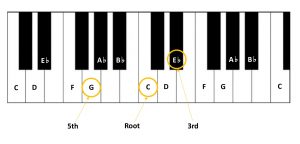
4 Essential Fundamentals of Music You Need to Start Playing the Piano
This 4-day bite-size free course is designed to help you get started on this journey on solid ground.
JOIN THE FREE COURSEHow to Bring Your Basic Piano Chords to the Next Level with Inversion (Video)
The basic piano chords and you are like soulmates. Everyday when you wake up, you say hi and basic piano chords say yo!

During breakfast, you two share the same cup of coffee and eat from each others plate. Then you go on doing the same thing together everyday.
Basic piano chords and you start to feel kinda bored with this mundane life. One day, basic piano chords says “If we’re gonna do this again, I’m gonna move out”.
Now if you don’t want to loose the basic piano chords, it’s time to spice things up a little. Time to bring your relationship up a notch.
In this article, that’s exactly what we’re gonna talk about. We’re gonna talk about the inversion. I use inversions and inverted chords interchangeably throughout this article.
If you prefer to watch this episode, scroll all the way down for the video. Can’t play sound right now or you prefer to read? Then continue reading my friend.
What is an inversion?
The word inversion in a dictionary means a reversal of position, order, form or a relationship.
If you’ve followed me in my previous post on basic piano chords, a basic triad chord consists of the root, the third and the fifth degree of its scale.
Now, altering the position of these three notes would produce inversion or inverted piano chords.
An inverted chord can either be in a close position or open position.
In a close position, the notes that make up the chord are closest to each other and you can’t find any other notes which are closer.
In an open position, the notes that make up the chord are played far apart. You kinda need both hands to play all them, unless you have extraordinarily long fingers ;-).
I will explain more on the close position and open position inverted chords below. But first….
Why need to play with inversion?
If you’ve been playing the basic triad chords all this while, they are great but if you want to sound more like a pro and bring your playing to the next level, playing inverted chords are the way to go.
Inversion allows you to create more variations to your chords. You’d hear the transition from one chords to another sound more natural and less abrupt. You’ll also notice that the chords sound more beautiful with inversions.
In this video, you’ll hear and see the difference between the chords progression C major – G major and F major played with just triads in root position and with inversions.
Close Position Inversions
In an close position inversions, the notes that make up the inverted chords are arranged as closely as possible.
The most basic position of a chord is known as tonic triad chord or triad in root position.
For inverted chords, the notes that make up the triads are of the same notes as the ones that make up a tonic triad chord or basic triad chord. The difference is only in the position of the notes.
As I mentioned earlier on, inversion means a reversal of position, order, form or a relationship of the notes in a triad.
The lowest note or the bass note (the most bottom note) of a triad gives the name of the inversion:
- When the bass note is the root note or keynote, the triad is in root position.
- When the bass note is the 3rd of the chord, the triad is called the first inversion.
- When the bass note is the 5th of the chord, the triad is called the second inversion.
1. The Tonic Triad Chord (Root Position)
Again, if you have followed me previously in Learn Piano Chords in Less Than 10 minutes, you would have seen that in a tonic triad chord, the bass note is always the key-note for example for E minor, the bass note is E.
This is followed by the 3rd note and 5th notes of its scale, which are G and B respectively. The triad arranged this way is also known as a triad in root position.
Using C major as an example, the scale consists of the notes, C, D, E, F, G, A, B and C. In root position, the interval between C to E is 3rd and from E to G is another 3rd.
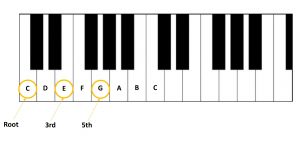 Similarly, in a minor key, in root position, the intervals between the root note to the 3rd note is 3rd and between the 3rd note to the 5th note is another 3rd.
Similarly, in a minor key, in root position, the intervals between the root note to the 3rd note is 3rd and between the 3rd note to the 5th note is another 3rd.
Here I’m using the example of C minor. The scale consists of the notes, C, D, Eb, F, G, Ab, Bb and C. So, the tonic triad chord of the key C minor consists of the notes C, Eb and G.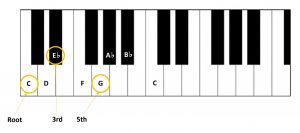
2. The First Inversion
I mentioned earlier on that the lowest note or the bass note (the most bottom note) of a triad gives the name of the inversion. When the bass note is the 3rd of the chord, the triad is called the first inversion.
In the first inversion of the key C major, the bass note is now E and the interval between E to G is 3rd and from G to C is 4th.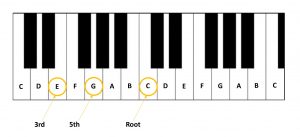 Similarly, in a minor key, using C minor as an example, the bass note is now Eb and the interval between Eb to G is 3rd and from G to C is 4th.
Similarly, in a minor key, using C minor as an example, the bass note is now Eb and the interval between Eb to G is 3rd and from G to C is 4th.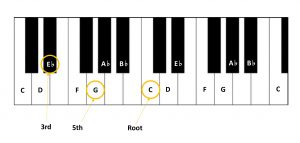
3. The Second Inversion
When the bass note is the 5th of the chord, the triad it is called the second inversion. In the second inversion of the key C major, the bass note is now G and the interval between G to C is 4th and from C to E is 3rd.
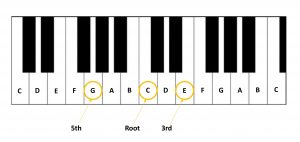
Using C minor as an example, the bass note is also G followed by C and Eb which are the root and 3rd notes respectively and the intervals between these notes are also 4th and 3rd.
Open Position Inversions
Ok, now that you have seen how inverted piano chords are placed closely together in the closed position, let’s see how they can be played in the open position.
What that means is that all of the notes in the inverted triads are played far apart. You will need both of your hands to play them.
Although the notes are played far apart, they are still described as being in a root position, first inversion or second inversion. However, the position or the intervals in between the notes are no longer than same.
Similarly, without adding or removing any notes from the existing notes in a tonic triad, we are going to re-arrange the notes for form first and the second inversion in open positions.
Using C major again as an example, the tonic triad of this key consists of the notes C, E, and G.
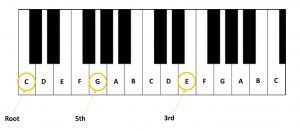
In the first and second inversion(open position), the most bottom notes remain the same as the most bottom notes of the first inversion and second inversion triads in the closed position.
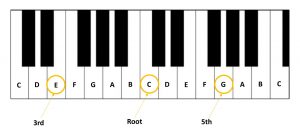
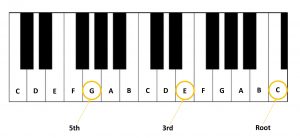
However, the intervals between the most bottom note to the note above it are no longer the same.
In the first inversion, intervals between the most bottom note to the note above it is now 6th and from that second note to the highest note is 5th.
In the second inversion, the interval between the most bottom note to the note above it is 6th and from this second note to the highest note above it is 6th.
How to Play the Inverted Chords
Now if you try to use the inverted piano chords instead of the basic triad chords, you will be able to hear just how natural they sound like. This subtle alteration causes a big difference in how the chords sound.
To get the idea of how to play the inverted chords, forward the video below all the way to almost the end.
Here’s what you can do practice:
- Start with the simplest and the most common chords progression of C major, G major and F major.
- Learn one key with its inverted chords one day at a time.
- Keep repeating: tonic triad chord – first inversion – second inversion. Play them in ascending and descending manner.
- Then train yourself with: second inversion – tonic triad – first inversion or different sequence. You get the point.
- Introduce a new key when you’re familiar with the first key.
- Then repeat the process.
Now, playing with the inverted piano chords is slightly more advance then playing with the basic piano chords. So, it can be quite challenging in the beginning but with practice, you’ll get the hang of it. I know you’re a rockstar and you got this!
Keep practicing and get familiar with all of the inverted chords until the point where they just glide through your fingers that you don’t have to look at the keys anymore. Kinda like typing on the keyboard without looking.
Learn the inverted chords with one key, one day at a time and you surely will get there in no time. Do let me know how you go with this new style of playing. I would love to hear from you.
Have fun and keep playing!
About The Author
Kaiyen Goh
Kaiyen helps music lovers and beginners who want to play the songs they love and create the songs they’ve always dreamed of writing. She also created a free course called “4 Essential Fundamentals of Music That You Should Know to Play Piano with Piano Chords”, where she aims to help people with no musical background to start playing the piano on solid ground.
Related Posts
Unlock the Secret: A Comprehensive Guide to How to Play Piano Fast Without the Overwhelm
Looking to learn how to play the piano by yourself? You’re at the…
THE 4 MUST-KNOW PIANO CHORDS FOR BEGINNERS
If you’re a beginner, I’m sure you’re excited to…

